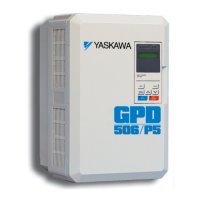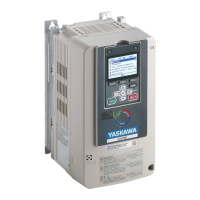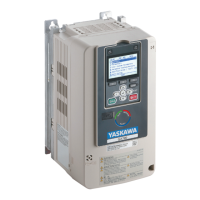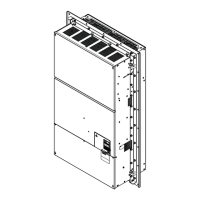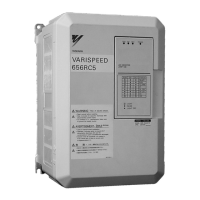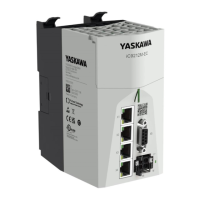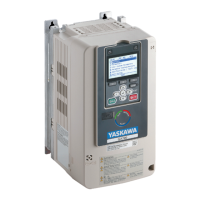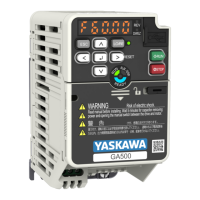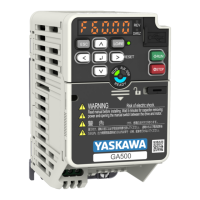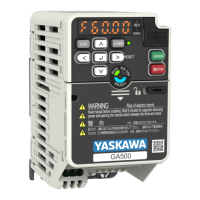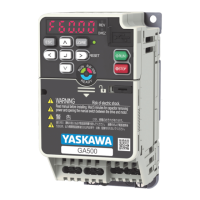7.10 Troubleshooting Without Fault Display
376 YASKAWA SIEPC71061705H GA700 Series Technical Manual
◆ The Correct Auto-Tuning Mode Is Not Available
Causes Possible Solutions
The desired Auto-Tuning mode is not available for the selected control
mode.
Change the motor control method with parameter A1-02 [Control Method Selection].
◆ The Motor Stalls during Acceleration or Accel/Decel Time Is Too Long
Causes Possible Solutions
The drive and motor system reached the torque limit or current suppression
will not let the drive accelerate.
• Decrease the load.
• Use a larger motor.
Note:
Although the drive has a Stall Prevention function and a Torque Compensation Limit
function, accelerating too fast or trying to drive a load that is too large can exceed the limits
of the motor.
Torque limit is set incorrectly. Set the torque limit correctly.
The acceleration time setting is too short. Check the values set in C1-01, C1-03, C1-05, or C1-07 [Acceleration Time] and set them to
applicable values.
The load is too heavy. • Increase the acceleration time.
• Examine the mechanical brake and make sure that it is fully releasing.
• Decrease the load to make sure that the output current stays less than the motor rated current.
• Use a larger motor.
Note:
• In extruder and mixer applications, the load can increase as the temperature decreases.
• Although the drive has a Stall Prevention function and a Torque Compensation Limit
function, accelerating too fast or trying to drive a load that is too large can exceed the limits
of the motor.
The frequency reference is low. • Examine E1-04 [Maximum Output Frequency] and increase the setting if it is set too low.
• Examine U1-01 [Frequency Reference] for the correct frequency reference.
• Examine the multi-function input terminals to see if a frequency reference signal switch has
been set.
• Examine the low gain level set in H3-03, H3-11, H3-07 [Terminal A1, A2, A3 Gain Setting] if
you use MFAI.
The frequency reference is set incorrectly. When H3-02, H3-10, H3-06 = 1 [MFAI Function Select = Frequency Gain] are set, see if voltage
(current) has been set.
• Check the values set in H3-02, H3-10, and H3-06.
• Use U1-13 to U1-15 [Terminal A1, A2, A3 Input Voltage] to make sure that the analog input
values set to terminals A1, A2, and A3 are applicable.
The motor characteristics and drive parameter settings are not compatible. • Set the correct V/f pattern to agree with the characteristics of the motor.
• Examine the V/f pattern set in E1-03 [V/f Pattern Selection].
• Perform Rotational Auto-Tuning.
The drive is operating in vector control mode, but Auto-Tuning is not
completed.
• Do Auto-Tuning.
• Calculate motor data and reset motor parameters.
• Set A1-02 = 0 [Control Method Selection = V/f Control].
Parameter A1-02 = 4 [Control Method Selection = Advanced Open Loop
Vector] and the speed estimation response is too slow.
Increase the value set in n4-65 [Flux Estimate Response@High Freq] in 0.1-unit increments.
The Stall Prevention level during acceleration setting is too low. Increase the value set in L3-02 [Stall Prevent Level during Accel].
Note:
If the L3-02 value is too low, the acceleration time can be unsatisfactorily long.
The Stall Prevention level during run setting is too low. Increase the value set in L3-06 [Stall Prevent Level during Run].
Note:
If the L3-06 value is too low, speed will decrease while the drive outputs torque.
Drive reached the limitations of the V/f motor control method. • When the motor cable is longer than 50 m (164 ft.), do Auto-Tuning for line-to-line resistance.
• Set the V/f pattern to “High Starting Torque”.
• Use a Vector Control method.
Note:
V/f control method does not provide high torque at low speeds.
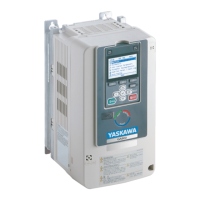
